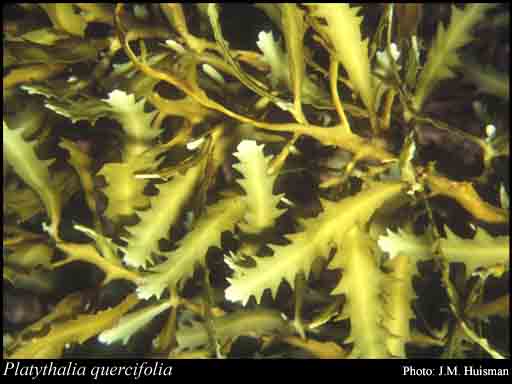- Reference
- Bot.Zeit. 51 (1845)
- Conservation Code
- Not threatened
- Naturalised Status
- Native to Western Australia
- Name Status
- Current

Scientific Description
Habit and structure. Thallus dark brown, 15–80 cm long, with one to a few essentially complanately branched axes from the holdfast. Holdfast stoloniferous, 0.5–2 cm across; epilithic. Axes flat, alternately pinnately branched and relatively straight, becoming denuded below, 3–6 mm broad and 0.5–1 mm thick, with marginal laterals (0.5–)1–2 cm apart. Laterals lying in the same plane as the axis but often basally twisted, simple or basally branched, (2– )4–10( –15) cm long and 4–10 mm broad, becoming slightly costate, basally constricted and tapering above, with well developed, subopposite to alternate, coarse marginal spines 2–5(–10) mm long. Structure of a medulla of elongate cells without rhizoids and a cortex of isodiametric cells with a surface phaeoplastic meristoderm.
Reproduction. Thalli dioecious. Receptacles developed from upper parts or the whole of the laterals. Conceptacles scattered, with surface ostioles, unisexual; oogonia sessile, ovoid, 100–130 µm long and 80–100 µm in diameter, with simple paraphyses; antheridia on branched paraphyses, ovoid, 30–40 µm long and 10–16 µm in diameter.
Distribution:From Shark Bay to the Recherche Archipelago, W. Aust.
[After Womersley, Mar. Benthic Fl. Southern Australia II: 404 (1987)]
Distribution
- IBRA Regions
- Esperance Plains, Geraldton Sandplains, Jarrah Forest, Swan Coastal Plain, Warren.
- IBRA Subregions
- Geraldton Hills, Perth, Recherche, Southern Jarrah Forest, Warren.
- IMCRA Regions
- Central West Coast, Leeuwin-Naturaliste, WA South Coast.
- Local Government Areas (LGAs)
- Albany, Augusta Margaret River, Busselton, Cambridge, Cockburn, Cottesloe, Esperance, Irwin, Manjimup, Rockingham, Wanneroo.